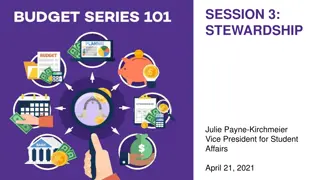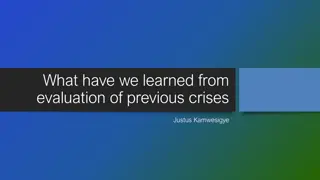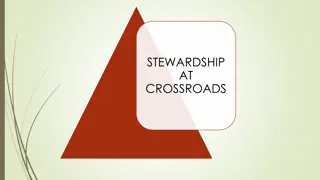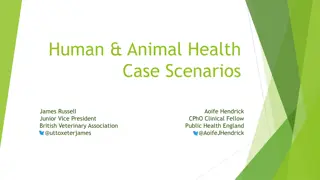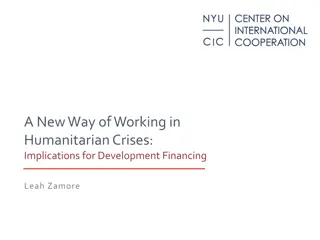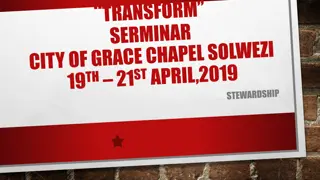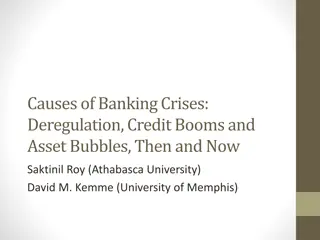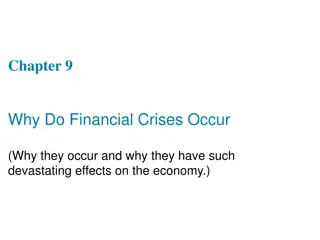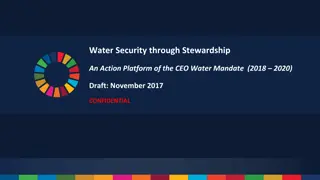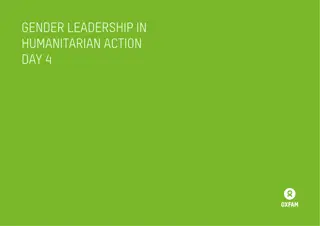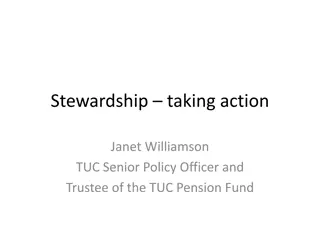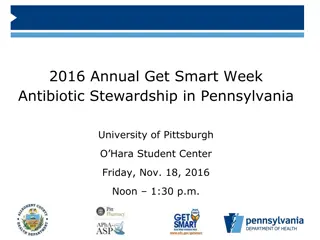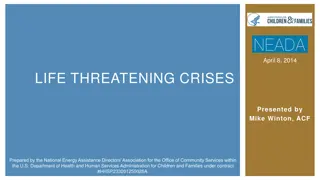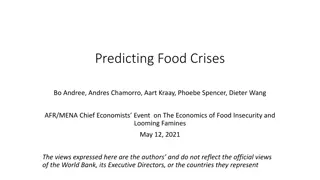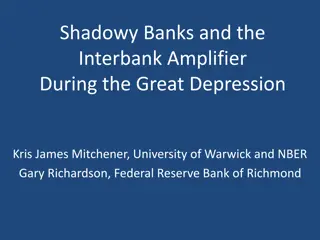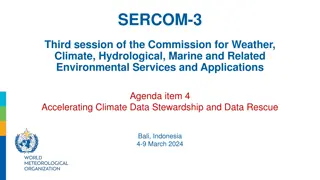Six Crises, One Dozen Opportunities in Public Stewardship Statistics
Explore the challenges and opportunities in public stewardship statistics through a series of crises and potential improvements. Key topics include stakeholder value, methodology, and the societal impact of official statistics. The presentation delves into various aspects such as design, stakeholder perceptions, and the importance of quality in statistical data.
Download Presentation

Please find below an Image/Link to download the presentation.
The content on the website is provided AS IS for your information and personal use only. It may not be sold, licensed, or shared on other websites without obtaining consent from the author.If you encounter any issues during the download, it is possible that the publisher has removed the file from their server.
You are allowed to download the files provided on this website for personal or commercial use, subject to the condition that they are used lawfully. All files are the property of their respective owners.
The content on the website is provided AS IS for your information and personal use only. It may not be sold, licensed, or shared on other websites without obtaining consent from the author.
E N D
Presentation Transcript
Six Crises Six Crises One Dozen Opportunities One Dozen Opportunities in Public in Public- -Stewardship Statistics Stewardship Statistics John L. Eltinge Assistant Director for Research and Methodology John.L.Eltinge@census.gov FCSM Virtual Conference November 2, 2021 Session C-2: Evidence and Data Policy
Acknowledgements and Disclaimer: The speaker thanks many colleagues in government statistical agencies, academia and the private sector for years of very helpful discussions of the topics discussed in this presentation. The views expressed in this presentation are those of the speaker and do not represent the policies of the United States Census Bureau. 2
Overview: Six Crises One Dozen Opportunities I. Public-Stewardship Statistics, Stakeholders and Methodology II. Six Perceived Crises III. One Dozen Opportunities Improve Understanding of Our Environment & Procedures Improve Design of Our Procedures 3
I. Public-Stewardship Statistics & Methodology What? Official Statistics - information to address key societal needs: Economic, public-health and demographic conditions Ex: Population Counts, Consumer Price Index, Unemployment Rate, Disease Prevalence Rates, National Accounts Static product form: Tables, maps and related analyses NASEM (2021) Principles and Practices, Seventh Edition 4
I. Public-Stewardship Statistics How? Conceptual and methodological basis: Primarily sample surveys (some administrative records) 1. Design: Allocate resources (sample units): optimize sampling variance, conditional on (approximate) unbiasedness, plus cost & operational constraints 2. Rich literature: Neyman (1934), Hansen et al (1953), Cochran (1977), Binder (1983), Fuller (1975, 2009), others 5
I. Public-Stewardship Statistics Why? (1) Perceived Stakeholder Value: Often via Concrete Use Cases Based on: Quality (Brackstone, 1999; others): Accuracy; Relevance; Granularity; Punctuality; Comparability; Interpretability; Accessibility; Credibility Risk: Prospective failure points; cumulative effects; trajectory of recovery; fault-tolerant designs Cost: All Resources Cash, Data, Time, Systems, Skills, Burden 6
I. Public-Stewardship Statistics Why? (2) Generally managed via public stewardship - Related to public goods some private-sector variants Multiple stakeholders - competing priorities - Trade-offs among multiple performance criteria: often complex, dynamic and conditional on environment - cf. wicked problems in design, e.g., Rittel & Webber (1973), Buchanan (1992), Lindberg et al. (2012), Thienen et al. (2014) 7
II. Six Perceived Crises in Public-Stewardship Statistics (1) Degradation of some dimensions of point estimation data quality Sample survey case: declining response rates (Tourangeau, 2017) Broader issues with some organic data (e.g., admin records): Population coverage, unit problems, timeliness, temporal and cross-sectional comparability multiple components of MSE (Groves, 2012; Couper, 2013; Citro, 2014; NASEM, 2017; Meng, 2018) 8
II. Crises (2): Reproducibility & Other Inferential Issues Substantive Inference and Fundamentals of the Scientific Process: How much does it cost to be sure enough? Sharing intellectual property? Vilhuber (2018), NASEM (2019), Efron (2020), many others Ioannidis (2005), Stodden et al. (2014), Wasserstein and Lazar (2016), Trade-offs among costs, inferential quality (current & future): study registration; data & code curation; verification/validation servers Some similarities to issues with methodological protections against bias in epidemiological studies, e.g., Keiding and Louis (2016) 9
II. Crises (3): Risks to Privacy and Confidentiality Database reconstruction theorem (Dinur and Nissim, 2003; related comments in Abowd and Schmutte, 2019) Differential privacy and allocation of privacy budgets Tiered access (Clark, 2020; others) account for item sensitivity? Secure multiparty computing and secure memory encryption Nuanced assessment of impact on all dimensions of data quality 10
II. Crises (4): Reduction in Discretionary Resources Resources: Many Components Intangible-Capital Intensive Ex: Data (both for production and internal controls), cash, calendar time, specified skills, systems, institutional capital, respondent burden, privacy budgets Often have high fixed costs with ambiguous attribution; indeterminate amortization; exacerbated by unfunded mandates Issue: Binding constraints on which resources? Feedback loops? 11
II. Crises (5): Changing Expectations on Public Stewardship and Public Goods Public goods: Weisbrod (1964), Arrow & Fisher (1974), Groshen (2018) non-exclusive and non-rivalrous unattainable (?) ideal Public stewardship: broader definition; expectations of generally level playing field and duty of care for long-term public benefit Implicitly based on positive-sum approach to societal (govt?) decisions Changes arising from societal heterogeneity (?) increased tendency toward zero-sum and negative-sum decision processes and outcomes 12
II. Crises (6): General Decline in Trust in Science, Expertise and Public Institutions Bates et al. (2012); Bauer et al. (2019; Fobia et al. (2019); Hunter-Childs et al. (2019); Pew (2019) - Per crisis #4, impact on survey response rates, access to admin records - Increased contention over use & interpretation of stat information In part: increased public recognition of context & conditioning In part: erosion of expectation of common base of facts Methods to measure underlying cognitive and social processes? 13
II. Six Perceived Crises: Diagnosis Prescription? Terminology: Perceived Crises and Crossroads: Crisis = Experiences do not match current/prior expectations e.g., Schlesinger (1957), Nixon (1962), Deming (1986) Related: Crossroads - Small et al. (2019), Abowd (2021) - Implies path dependence and impact on societal norms Analyze impact Options for changes in design (writ large) 14
III. One Dozen Opportunities: Structure of Crises? (1) Perceived value for stakeholders (often via concrete use cases) will depend on target parameters ?and performance profile ? = (???????,????,????) = ???,?; + ? ? = = Design vector (targeted resource decisions) ? = Environment (observed, uncontrolled) e =residual effects (uncontrolled, unobserved) = parameters of performance profiles, dispersion ???????,???????,???? ??,???????,?????? 15
III. One Dozen Opportunities: Structure of Crises? (2) Conjecture: Characterize crises connections with changes in: 1. Environment ? : different point in space stability of ?? 2. Constraints on design factors ? , performance profiles ? (e.g., reduced variance, cost, operational risk) 3. Functions for performance (quality, risk, cost) ? or stakeholder value ? (depends on ? and environment ? ) Suggestions for mitigation (and improvement) through changes in ?? 16
III. Opportunities: Improve Understanding of Procedures A. The market: Who are the key stakeholders and what are their statistical information needs? Set of estimands ? , and stakeholders ? ? Conditional (on ?, ,?? ) distributions of ?? = (???????,????,????) = ??? ?? ,?? ; + ?? (cf. variability of quality over small domains) 17
III. Opportunities: Improve Understanding of Procedures B. Realistic schematic and empirical descriptions of our stakeholder utility functions? Concrete use cases? Extend (A): Conditional distributions of utility functions ?? ? Dominant terms , ? ?, , ?? , ?? ? Methodological question: Empirical information on stakeholder utility through Bayesian elicitation methods, e.g., Garthwaite et al. (2005), O Hagan et al. (2006)? 18
III. Opportunities: Improve Understanding of Procedures C. What are realistic schematic models for our production function and for our performance dimensions ?, including quality, risk and cost? Also: To what extent can we quantify these models? Dominant (global) factors? Local approximations? Cf. rational groupings in formation of variance function models 19
III. Opportunities: Improve Understanding of Procedures D. Finding the best levers: Which design factors ? can we control? How well can we really control them, at what cost, and within what operating constraints? Characterize effects of: - Slippage issues - Distinctions between one-time experimental results and robust production-level performance at scale 20
III. Opportunities: Improve Understanding of Procedures E. Roles of public stewardship and public goods requirements? Quantify: Environmental variables Z for V ? Constraints on ? or ?? Public expectations on specific high-profile statistical information - Groshen (2018), Hess and Ostrom (2006), Rolland (2017) Summers (2016), Taylor (2016), Teoh (1977) and Trivellato (2017) Pattern of statistical information developed in response to specific high-profile needs, e.g., Hughes-Cromwick and Coronado (2019) 21
III. Opportunities: Improve Understanding of Procedures F. What do we not know, and how do we learn more? Right choices for crucial dimensions of quality, risk, cost, stakeholder value, design factors, environmental conditions? Realistic framing of decisions based on this information? Quality of information required for realistic decision? 22
III. Opportunities: Improve Design of Procedures A. Change the target stakeholder groups and product mix: Areas consistent with positive-sum public stewardship? Realistic trajectories for changes in usage patterns Severe asymmetries in perceived utility effects: Addition of new data series vs. loss of previous series Methodological note: Extend elicitation methods to evaluate gains and losses? (O Hagan et al., 2006) 23
III. Opportunities: Improve Design of Procedures B. Align commitments on quality/risk/cost profiles with operating constraints and stakeholder priorities (NASEM, 2021) Ex: Priorities related to classes of inferential questions: - Association (correlation; contingency tables) - Satisfactory predictive models? Congressional Budget Office - Causality (e.g., Imbens and Rubin, 2016) - Beyond causality to outright control? (cf. Goroff, 2020; Foundations of Evidence-Based Policymaking Act of 2018) - Simple descriptive statements (e.g., means, totals) 24
III. Opportunities: Improve Design of Procedures C. Move the lever: Incremental changes of settings of design factors ? Methodological question: Designs to capture realistic information on - Constraints and costs of specified prospective changes - Risks incurred with specified changes & options to mitigate? Extend usual evolutionary operation & adaptive designs 25
III. Opportunities: Improve Design of Procedures D. Improve the lever: More refined control over design factors, accounting for slippage issues and adaptive design options Methodological note: Characterize and measure ways in which adaptive, responsive and agile procedures substantially improve quality, or reduce costs and risks 26
III. Opportunities: Improve Design of Procedures E. Produce more fundamental change: Add entirely new design factors, with fundamentally changed cost structures, quality effects and risk profiles Ex: More administrative records; enhanced online surveys Major change in functional form or parameters of performance profile ?: Need extensive exploratory work Disruptive innovation Haphazard 27
III. Opportunities: Improve Design of Procedures F. Improve stakeholder communication and negotiation Reality check: Zones for clarity, consensus & limitations - Practical measures of performance profile ? truly aligns with key stakeholder value function ? ? - Communicate alignment and uncertainties to resonate deeply with stakeholders? Connect numbers with stories 28
IV. Closing Remarks A. Six Perceived Crises B. Framing Through Schematic and Empirical Models for Quality, Risk, Cost, Stakeholder Value and Related Constraints C. One Dozen Opportunities Research & Operations Improve Understanding of Environment & Procedures Improve Design of Our Procedures 29
Thank You! 30
References: References: Abowd, John M. (2021). Official Statistics at the Crossroads: Data Quality and Access in an Era of Heightened Privacy Risk. The Survey Statistician 83, 23-26. Abowd, John M. and Ian M. Schmutte (2019) An Economic Analysis of Privacy Protection and Statistical Accuracy as Social Choices, American Economic Review, Vol. 109, No. 1 (January):171-202, DOI:10.1257/aer.20170627. Bates, Nancy, Monica J. Wroblewski, and Joanne Pascale (2012). Public Attitudes Toward the Use of Administrative Records in the U.S. Census: Does Question Frame Matter? Proceedings of the 2012 FCSM Conference. Available through: https://nces.ed.gov/FCSM/pdf/Wroblewski_2012FCSM_III- A.pdf Bauer, Paul C., Florian Keusch and Frauke Kreuter (2019). Trust and Cooperative Behavior: Evidence from the Realm of Data-Sharing. PLOS One. https://journals.plos.org/plosone/article?id=10.1371/journal.pone.0220115 Binder, David A. (1983). On the Variances of Asymptotically Normal Estimators from Complex Surveys. International Statistical Review 51, 279-292. 31
Box, George E.P. and N.R. Draper (1969). Evolutionary Operation: A Statistical Method for Process Improvement. New York: Wiley Buchanan, Richard (1992). Wicked Problems in Design Thinking. Design Issues, 8 (2), 5-21 Cho, Moon Jung, Eltinge, John L., Gershunskaya, Julie and Huff, Larry (2014). Evaluation of Generalized Variance Functions in the Analysis of Complex Survey Data. Journal of Official Statistics, 30, 63-90. Citro, Constance F. (2014). From Multiple Modes for Surveys to Multiple Sources for Estimates. Survey Methodology Journal40, 137-161. Clark, Cynthia Z.F. (2020). COPAFS-Hosted Tiered Access Workshops. Presentation to the Council of Professional Associations on Federal Statistics, March 6, 2020. Available through: https://copafs.org/wp- content/uploads/2020/03/CLARK-COPAFS-hosted-Tiered-Access-Workshops-rev.pdf Cochran, W.G. (1977). Sampling Techniques, Third Edition, New York: Wiley. Deming, W. Edwards (1986). Out of the Crisis. Cambridge, Massachusetts: Massachusetts Institute of Technology Center for Advanced Engineering Study. Dillman, Don A. (1996). Why Innovation is Difficult in Government Surveys (with discussion). Journal of Official Statistics, 12, 113-197. 32
Dinur, I. and Nissim, K. (2003). Revealing information while preserving privacy, Proceedings of the Twenty-second ACM SIGMOD-SIGACT-SIGART Symposium on Principles of Database Systems, PODS 03, ACM, New York, NY, USA, pp. 202 210. Efron, Bradley (2020) Prediction, Estimation, and Attribution, Journal of the American Statistical Association, 115:530, 636 655, DOI: 10.1080/01621459.2020.1762613. Fobia, A.C. J. Holzberg, C. Eggleston, J. Hunter-Childs, J. Marlar and G. Morales (2019). Attitudes Towards Data Linkage for Evidence-Based Policymaking. Public Opinion Quarterly 83 (S1), 264-279. Fuller, W.A. (1975). Regression analysis for sample survey. Sankhy , Series C, 37, 117-132. Fuller, W.A. (2009). Sampling Statistics. New York: Wiley. Garthwaite, Paul H., Kadane, Joseph B. and O'Hagan, Anthony (2005). Statistical methods for eliciting probability distributions. Journal of the American Statistical Association, 100, 680 701. 33
Goroff, Daniel (2020). Data Dreams and the Everyday Economics of Evidence, Inference and Governance. ASA Links Award Lecture, December 8, 2020. Available through: https://www.amstat.org/ASA/Your- Career/Awards/Links-Lecture-Award.aspx Groshen, Erica L. (2018). Views on advanced economy price and wage-setting from a reformed central bank researcher and national statistician. Proceedings of the Conference on Price and Wage-Setting in Advanced Economies, ECB Forum on Central Banking, pp. 267-283. Available through: https://www.ecb.europa.eu/pub/pdf/sintra/ecb.forumcentbank201810.en.pdf Groves, Robert M. (1989). Survey Errors and Survey Costs. New York: Wiley. Groves, Robert M. and S.G. Heeringa (2006). Responsive Design for Household Surveys: Tools for Actively Controlling Survey Errors and Costs. Journal of the Royal Statistical Society, Series A 169, 439-457. Hansen, Morris H., William N. Hurwitz and William G. Madow (1953). Sample Survey Methods and Theory, Volumes 1 and 2. New York: Wiley. Hess, Charlotte and Elinor Ostrom, (eds) (2006). Understanding Knowledge as a Commons: From Theory to Practice. Cambridge, Massachusetts: MIT Press. 34
Hunter-Childs, Jennifer, Fobia, Aleia C., King, R. and Morales, G. (2019). Trust and Credibility in the U.S. Federal Statistical System. Survey Methods: Insights from the Field. Survey Insights: Methods from the Field. Retrieved from https://surveyinsights.org/?p=10663 DOI:10.13094/SMIF-2019-00001 Imbens, Guido W. and Donald B. Rubin (2015). Causal Inference for Statistics, Social and Biomedical Sciences: An Introduction. New York: Cambridge University Press. Ioannidis, John P.A. (2005). Why Most Published Research Findings Are False. PLOS Medicine 2(8): e124. https://doi.org/10.1371/journal.pmed.0020124 Jordan, Michael I. (2019). Artificial Intelligence The Revolution Hasn t Happened Yet. (with discussion and rejoinder). Harvard Data Science Review 1 (1). https://doi.org/10.1162/99608f92.f06c6e61 Keiding, Niels and Thomas A. Louis (2016). Perils and Potentials of Self Selected Entry to Epidemiological Studies and Surveys (with discussion). Journal of the Royal Statistical Society, Series A179, 319-376. https://doi.org/10.1111/rssa.12136 Kish, Leslie (1965). Survey Sampling. New York: Wiley. Lindberg, T., K ppen, E., Rauth, I. & Meinel, C. (2012). On the Perception, Adoption and Implementation of Design Thinking in the IT Industry. In H. Plattner, C. Meinel and L. Leifer (Eds.), Design Thinking Research. Studying Co-Creation in Practice (229-240). Berlin: Springer. 35
Meng, Xiao-Li (2018). Statistical Paradises and Paradoxes in Big Data (I): Law of Large Populations, Big Data Paradox and the 2016 U.S. Presidential Election. Annals of Applied Statistics 1-42. National Academies of Sciences, Engineering, and Medicine (2017). Federal Statistics, Multiple Data Sources, and Privacy Protection: Next Steps. Washington, DC: The National Academies Press. https://doi.org/10.17226/24893. National Academies of Sciences, Engineering, and Medicine (2019). Reproducibility and Replicability in Science. Washington, DC: The National Academies Press. https://doi.org/10.17226/25303 National Academies of Sciences, Engineering, and Medicine (2021). Principles and Practices for a Federal Statistical Agency: Seventh Edition. Washington, DC: The National Academies Press. https://doi.org/10.17226/24810 Neyman, J. (1934). On the Two Different Aspects of the Representative Method: The Method of Stratified Sampling and the Method of Purposive Selection. Journal of the Royal Statistical Society 97, 558-625. Nixon, R.M. (1962). Six Crises. New York: Simon and Schuster. 36
OHagan, A., C.E. Buck, A. Daneshkhah, J.R. Eiser, P.H. Garthwaite, D.J. Jenkinson, J.E. Oakley and T. Rakow (2006). Uncertain Judgements: Eliciting Experts' Probabilities. Chichester: Wiley. Pew Research Center (2019). Americans and Privacy: Concerned, Confused and Feeling Lack of Control Over Their Personal Information. November, 2019. Available through: https://www.pewresearch.org/internet/2019/11/15/americans-and-privacy-concerned-confused- and-feeling-lack-of-control-over-their-personal-information/ Rigby, Darrell K., Jeff Sutherland and Hirotaka Takeuchi (2016). The Secret History of Agile Innovation. Harvard Business Review https://hbr.org/2016/04/the-secret-history-of-agile-innovation Rittel, H. W. J. & Webber, M. M. (1973). Dilemmas in a General Theory of Planning, Policy Sciences, 4, 155-169. Rosenblum, Michael, Peter Miller, Benjamin Reist, Elizabeth Stuart, Michael Thieme and Thomas Louis (2019). Adaptive Design in Surveys and Clinical Trials: Similarities, Diffferences, and Opportunities for Cross-Fertilization. Journal of the Royal Statistical Society, Series A Schlesinger, Jr., Arthur M. (1957). The Age of Roosevelt: The Crisis of the Old Order, 1919-1933. New York: Houghton Mifflin. 37
Simon, H. A. (1956). "Rational Choice and the Structure of the Environment." Psychological Review63 (2), 129 138. Small, D., D. Banks, B. Yu, X. He, M. Jordan, D. Madigan, M. Markatou (2019). Statistics at a Crossroads: Who Is for the Challenge? Presentations at JSM 2019 Late-Breaking Invited Session. Materials available through: https://ww2.amstat.org/meetings/jsm/2019/onlineprogram/AbstractDetails.cfm?abstractid=307986 Stodden, V, F. Leisch and R.D. Peng (2014). Implementing Reproducible Research. London: CRC Press Summers, L. (2016). The Future of Price Statistics. Available through: http://larrysummers.com/2016/04/01/world-bank-price-stats/ Taylor L. (2016). The Ethics of Big Data as a Public Good: Which Public? Whose Good? Philosophical Transactions of the Royal Society, A 374: 20160126. http://dx.doi.org/10.1098/rsta.2016.0126 Teoh, Siew Hong (1997). Information Disclosure and Voluntary Contributions to Public Goods. RAND Journal of Economics28, 385-406. Thienen, J. P. A. von, Meinel, C. & Nicolai, C. (2014). How design thinking tools help to solve wicked problems. In H. Plattner, C. Meinel and L. Leifer (eds.), Design thinking research. Building innovation eco-systems (97-102). Berlin: Springer. 38
Tourangeau, Roger (2017). Presidential Address, American Association for Public Opinion Research. May 19, 2017, New Orleans, Louisiana. Trivellato, Ugo (2017) : Microdata for Social Sciences and Policy Evaluation as a Public Good, IZA Discussion Papers, No. 11092, Institute of Labor Economics (IZA), Bonn. Available through: https://www.econstor.eu/bitstream/10419/174002/1/dp11092.pdf Valliant, Richard (1987). Generalized Variance Functions in Stratified Two-Stage Sampling. Journal of the American Statistical Association82, 499-508. Vilhuber, Lars (2018). Reproducibility and Replicability in Economics. White paper prepared for the National Academies' Committee on Reproducibility and Replicability in Science. Wasserstein, Ronald L. and Nicole A. Lazar (2016). The ASA Statement on p-Values: Context, Process, and Purpose, The American Statistician, 70:2, 129 133, DOI: 10.1080/00031305.2016.1154108 https://amstat.tandfonline.com/doi/full/10.1080/00031305.2016.1154108#.X9P1ifk3nIU 39


